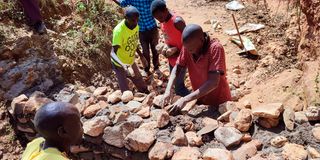Build more sand dams for permanent water security

Community members construct a sand dam in Senatwo, West Pokot County.
Climate change has had a severe impact on the world’s freshwater supply. The United Nations addressed this urgent issue by including water-related issues as the sixth goal of 17 in its 2030 Agenda for Sustainable Development in 2015. Unfortunately, by 2030, the demand for water worldwide is projected to exceed sustainable supply by a worrying 40 per cent.
Water insecurity is a growing biodiversity challenge. We must address the problem and arrive at immediate and innovative solutions. While there are numerous solutions, one of the least deployed, but very effective solutions is a sand dam.
Sand dams are structures built across seasonal rivers and streams in arid and semi-arid regions to harvest and store water obtained when it rains.
They capture and store water during the rainy season or whenever it rains. This increases the availability of water throughout the year, reducing dependence on seasonal rainfall and providing permanent water security.
Evaporation and runoff
The larger the volume of sand, the larger the amount of water it retains. There is no water loss through evaporation and runoff, which are common in arid and semi-arid regions. They are also free of human and animal pollution.
The dams also add water to the water table and provide it to the environment.
They are a low-cost solution as they only require pump installation, usually a hand pump on a specially designed artisan well. They last for decades without any major refurbishment.
They provide a reliable source of water for domestic, livestock, and small-scale agriculture use.
Sand dams naturally filter and purify water, reducing the risk of waterborne diseases.
Additionally, they provide water for irrigation and thus enable the cultivation of crops and vegetables throughout the dry season.
Furthermore, they help to conserve biodiversity by providing a habitat for plants and animals that are adapted to arid and semi-arid conditions.
They have a positive impact on climate change as they provide a reliable source of water during times of drought.
Sand dams improve community health and well-being as users are able to maintain better hygiene practices. This helps prevent diseases In addition, communities can grow more nutritious crops, which can improve their income and diets.
The APA Apollo Foundation, in collaboration with local communities, has built 36 sand dams.
The communities are taught improved farming methods in a way that enhances social cohesion and community ownership of the project.
When the dam is built, seedlings of economically beneficial trees are given to the community.
Mr Shah is a Trustee of the APA Apollo Foundation and Group CEO of Apollo Investments.




